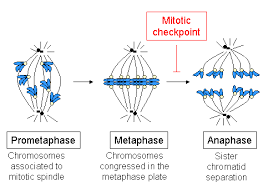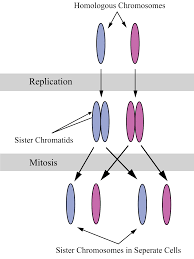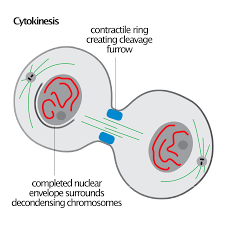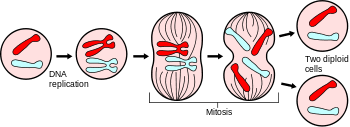mitosis
Mitosis was first observed by Strasburger in the plant cell and by Walter Flemming in animal cell Theterm mitosis was given by Walter Flemming in 1882.
Definition:- Mitosis is a process in which a parent cell divides into two indentical daughter cells. These cells are indentical to each other as well as to the parent cell. It is a type of division in which already duplicated chromosomes are distributed into two daughter cells equally, so that both the cells have the same number of chromosomes
mitosis mechanism :-
- Karyokinesis:- Karyokinesis is a continuous process in which a parent nucleus divides into two daughter nuclei. There is no pause during the process but for our convenience, mitosis has been divided into four stage of nuclear division.
(i) Prophase:– ‘Pro’ means first and ‘phase’ means stage. The following events occur during prophase:
(a) The condensation of chromatin material takes place and during condensation, the DNA strands get untangled to form compact mitotic chromosomes.
(b) Each chromosomes appears double and consists of two coiled sister chromatids joined by a centrmere. Their ends are not visible in early prophase. Therefore, the chromosomes appear like a ball of wool. It is also called spireme stage.
(c) Centrosome which had undergone duplication during interphase, begins to move towards the opposite poles of the cells.
(d) Each centrosome radiates out microtubules called asters. The two asters together with spindle fibres form mitotic apparatus.
(e) In animal cells, mitosis is called Amphiastral (spindle is associated with 2 asters). In plant cells, the mitosis is Anastral (no aster formation).
(f) Cells at the ends of prophase, when viewed under the microscope, do not show golgi complex, ER, nuclear membrane and nucleous.
If the nuclear membrane disappears during the mitosis it is called Eumitosis or extranuclear and if mitosis is intrnuclear means nuclear membrance remains intact then it is called Premitosis e.g., many protists and fungi
(ii) Metaphase:- ‘Mete’ means second and ‘phase’ means stage. The following events occur during metaphase.

(a) The disintegration of the nuclear envelope marks the beginning of the metaphase. The nuclear envelope disappears, and chromosomes spreads through the cytoplasm of the cell.
(b) The chromosomes contain two chromatids attached to each other through the centromere. The chromosomes during this stage are the thickest and shortest and hence, it is easy to study their morphology.
(c) Mitotic spindle formation is complete. The phenomenon of bringing the chromosomes on the equator of spindle is called congression.
(d) All the chromosomes align themselves at the equator. The plane of alignment of centromeres of all the chromosomes is referred as metaphasic plate or equatorial plate.
(e) The centromere is surrounded by a small disc- shaped structure called kinetochore. The kinetochores forms the site of attachment of microtubules (spindle fibres).
NOTE: Colchine inhibits mitosis by inhibiting formation of microtubules (naturals mitotic poison)
(3) Anaphase: ‘Ana’ means up and ‘phase’ means stage. Following events occur during during anaphase:
(a) The chromosomes which holds the two chromatids together splits and separated daughter chromatids are now referred to as chromosomes of the future daughter muclei.

(b) The spindle fibres attached to the kinetochore now shorten and daughter chromosomes begin to migrate towards the opposite poles. Formation of interzonal fibres occurs.
(c) During migration, chromosomes always move away from the equatorial plate. The centromere of the daughter chromosomes move towards the pole and the arms of chromosomes trail it. The snaphase ends when the chromosomes reach the poles. It is the best stage to study shape of chromosomes (V,L,J,I).
(4) Telophase: ‘Telo’ means end and ‘phase’ means stage. The following events occre during telophase:
(a) The chromosomes (sister chromatids) reach their respective poles. The mitotic spindle disappear.
(b) After the poles, the chromosomes decondense and lose their individuality. The individuality chromosomes can no longer be seen and each set of chromatin materials tends to collect at each of the two poles.
(c) Nuclolus, endoplasmic reticulum, golgi bodies, and other organelles reappear in the daughter cells.
(d) The nuclear envelopes develops around the chromosomes clusters at each pole forming two daughter nuclei.

Mitosis Cytokinesis
: is the final step in the process of cell division, occurring after mitosis, where the cytoplasm of a parent cell is divided into two daughter cells. This process ensures that each daughter cell receives an equal and adequate amount of cytoplasm and organelles, completing the cell division process.
Significance of mitosis
1. Growth- Mitosis is essential for the growth and development of multicellular organism.
2. Maintaince of cell size: Mitosis maintains the size of the cell. An overgown somatic cell is induced to divide, if a cell becomes large, then it enters into mitosis
- Repair: Mitosis is a mechanism for replacing old dead and worn out cells.
4. Reproduction: Mitosis brings about reproduction (multiplication) in unicellularorganism. - Healing and regeneration: Mitosis produces new cells for healing the wounds and for regeneration.
MITOSIS NOTE:
Mitogens are substances which induce mitosis, e.g., Auxin, Cytokinin, Gibberaline, Insulines.
